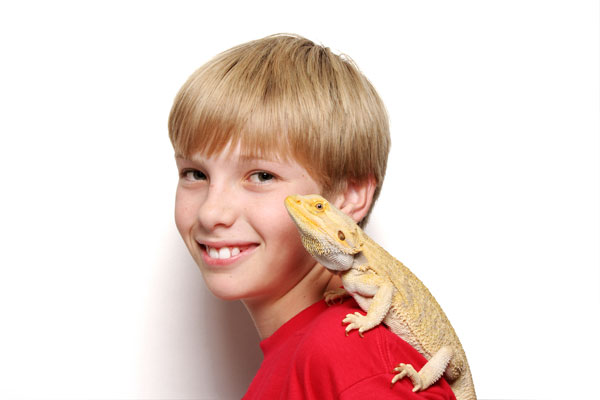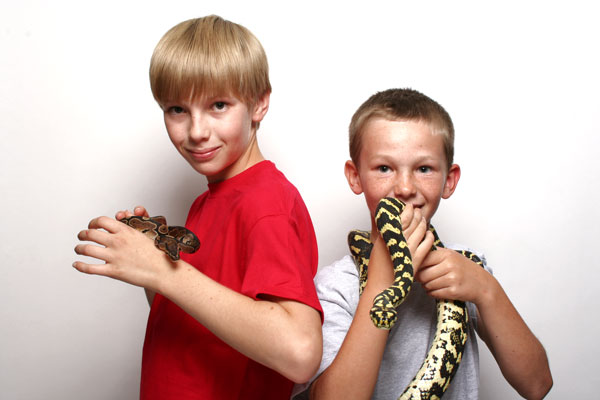Reasons why children should keep reptiles.
Can I get a dog? Or a hamster? Or a boa constrictor?”
These days many parents are likely to be asked by their children to get a pet reptile. Reptiles are more prevalent than ever, after all. Not only are they on display in pet and reptile stores, but they also appear in movies, commercials and other media outlets. Whether this is a good thing or not — the “not” because of the possibility of impulse buying — whenever an animal is featured in, say, television commercials, a demand for that animal can arise, especially on behalf of children. One wonders how many giant day geckos have been sold as a result of the Geico gecko,chihuahuas because of the Taco Bell chihuahua, clown fish because of the movie Finding Nemo, and so on.

Personally, I love the fact that children are fascinated by reptiles and plead with their parents to keep them as pets. Luckily, reptiles can make great pets for them, provided the right approach is taken.
Too Cool for Thought
Being informed about an animal may seem like a no-brainer, but it has to be hammered home anyway. Many people buying reptiles, especially kids, can get so caught up in the “coolness factor” of the animals that they surrender to impulse buying, which is when an animal is purchased without any real thought as to its suitability as a pet for that particular person — not just now but in the future, too.
Whether you are asking a parent for a herp pet or a parent who has just been asked, there are three important things to consider regarding pet reptiles in general.

Gina Cioli/BowTie Studio
Many reptiles can live a long time. Will your 12-year-old still want that tortoise when he or she (the kid, not the tortoise) is 20 years old? How about 50 years old? Tortoises are famous for being long-lived, but many herps can live longer than 10 years.
Cute baby reptiles can get big. Visit an animal rescue and ask how often they take in green iguanas, large constrictor snakes or African spurred tortoises. These species are the primary candidates for the grew-too-big-for-me-to-take-care-of-it category, but additional reptiles, such as most monitors, tegus,red-eared sliders and others, may outgrow enclosures that were fine for them as babies but are no longer.
Will the animal get the proper care? Proper husbandry is a must for any animal whether it’s scaly, furry or feathery. Knowing how long animals will live and how big they get is important, but a herp’s specific care requirements should be researched — and determined realistic for a youngster to provide — before it is brought home.
The good news is not all reptiles are very demanding pets. This is one huge reason why some make great pets for children. Read on, and you’ll find there are seven other reasons why reptiles make great pets for young people.

Gina Cioli/BowTie Studio
1. Reptiles are “Low-Maintenance” Pets.
Pets such as dogs and cats, though beloved by millions, require a lot of attention. Reptiles don’t.
For one thing, pet reptiles don’t need to be fed every day. Every other day is fine, and some don’t even need to be fed that much. Although not recommended for children, huge pythons have been known to go a year without eating! I would never recommend that a pet snake be fed only once a year, but only feeding them a couple times a week is fine.
When discussing pets, the issues of hair and the maintenance that goes along with it often come up. I wonder how many owners of long-haired dogs and cats wish their pets didn’t require all that maintenance and cleaning. Grooming their beloved pets may be a labor of love for many, I suppose, but consider the convenience of keeping a reptile. It doesn’t have to be groomed, and people are not likely to be allergic to it.
Another facet of a reptile’s low-maintenance reputation is in regard to the animal’s need for owner interaction. This is aside from what’s required for general health, such as feeding and cleaning. Reptiles need both — like any pet. But dogs, for instance, need their owners’ love and attention for their psychological well-being. Neglected dogs can become depressed and frustrated, which can result in damaging behavior. This is one characteristic that makes dogs so endearing to so many people — not because they may misbehave and chew on your coffee table, but because they crave affection from “their people.”
Reptiles don’t crave affection from their owners. Although many accept handling, most are simply tolerating it. Some may actually enjoy being handled, and many reptile owners say their pets love being held. The bottom line, though, is that reptiles are also content to be left alone, and they won’t chew up your furniture if you do so.
Moreover, there’s this: A pet reptile doesn’t need to be taken for a walk to go to the bathroom.
|
|
2. Reptiles Don’t Require Much Space
You already know how large a reptile gets is an important nugget of knowledge to possess. Some can get very big. African spurred tortoise hatchlings, for instance, are the essence of cute when you see them marching around their enclosures like little tanks. But over the years those cute little tortoises turn into behemoths. Granted, the adults could still be considered cute, but I’m not sure how cute you will think they are if one has burrowed into your backyard and unearthed your entire sprinkler system.
The reptile species I recommend for children (see “Case’s Dozen” sidebar) remain a manageable size and will not require a room-sized enclosure. Most will do fine in a 20-gallon terrarium or enclosure of similar dimensions: approximately 3 feet long and 1½ feet wide. Some, such as a single crested or leopard gecko, or a kingsnake, could even be kept in a 10-gallon terrarium. Turtles and tortoises will need more space. The leopard tortoise, for instance, can grow to about 20 inches in length and weigh 30 pounds; it will eventually need a pen in which to roam.
Yet the space a reptile requires for exercise is meager compared to some pets. Here again I’m thinking of dogs and how they need space to run and play. For this there are dog parks, but when was the last time you saw a reptile park? They don’t exist because reptiles don’t need to exercise the way dogs do. The space within their enclosures is all they require.
3. Reptiles are Easy to Feed
Insects and rodents are readily available. Plus, some reptiles from my list such as bearded dragons and tortoises eat fruits and veggies. There are commercial diets for reptiles, too.
If you keep one of the snakes on the list but don’t like the idea of feeding it live mice or rats, there is an alternative: frozen rodents. They are widely available. Just remember to thaw them before offering them to your snake, and don’t use the microwave, or things could get gross. You can use hot water to thaw them. You may have to jiggle them a bit using long forceps to get the snake to strike.
One argument for feeding frozen rodents rather than living ones is that live rodents can bite snakes or harbor parasites that may harm the pets. Such parasites die during the freezing process.
Yet many hobbyists prefer to feed live rodents to their snakes. Many find a snake’s feeding behavior interesting to watch. When feeding live rodents, though, never leave one in a snake enclosure unattended, especially overnight. A live mouse or rat could gnaw on your snake and cause it severe injury.
When it comes to lizards, turtles and tortoises, a variety of commercially prepared diets are available. These are manufactured with the animals’ nutrition requirements in mind. Although they could be considered complete diets, it’s a good idea to vary your pet’s menu. For example, owners of bearded dragons could offer crickets one day, a salad the next and then a commercial diet.
To make herp food healthier for your pets, you often want to add a calcium, vitamin and/or mineral supplement. Usually in powder form, these supplements can be applied to insects. Place bugs in a plastic bag with some of the supplement, inflate the bag with air, and shake it up and down until the insects are coated with the power. Then offer them to your lizard. Powder can also be sprinkled onto veggies and fruits.
4. Keeping Reptiles Provides a Lesson in Responsibility.
Being fairly “low-impact” animals, reptiles are better candidates to teach youngsters how to care for a pet than more high-maintenance animals. They are less likely to suffer the consequences of neglect as quickly as other pets.
No pet should suffer neglect, but children are known to occasionally forget to feed pets or clean their cages. Reptiles hold up to this sort of situation better than other pets. Of course, if the situation continues for too long, it’s not healthy for the reptile either. At that point the parent may have to step in, but the basic principle holds true: reptile care is not as much of a chore as caring for other types of pets.
If a feeding is missed or other care requirement temporarily neglected, parents can discuss with their children how important it is to care for the reptile properly and correct the behavior accordingly. In the meantime, the reptile likely is none the worse for wear (unless the neglect is allowed to go on for too long — and nobody should let that happen).
5. Reptiles Foster Interest in the Natural World.
Reptiles are more exotic than other pets, which is a large part of their appeal. This is also the reason many television nature shows on Animal Planet and Discovery Channel focus on reptiles. Nature shows are often children’s first exposure to reptiles and can provide the motivation for their wanting to own some.
My earliest realization probably resulted from watching Mutual of Omaha’s Wild Kingdom. Marlin Perkins, a former curator of reptiles at the St. Louis Zoo, and Jim Fowler hosted the show. Marlin and Jim could be considered the predecessors to Steve Irwin and Jeff Corwin, but I doubt anyone would accuse Marlin of exhibiting anywhere near the energy level of these younger whippersnappers. Jim often handled the down-and-dirty encounters while Marlin narrated the show.
The reptile scenes during Wild Kingdom episodes, such as Jim wrestling a giant snake, were always highlights that got my interest in reptiles percolating. Soon I began looking for herps to catch and keep, and my love of nature is due in large part to my interest in reptiles. They were the primary reason I was out in nature in the first place. As I grew more interested in reptiles, I grew to love nature more as a whole.
6. Reptiles Don’t Pose Much Risk of Personal Injury.
Sure, a pet reptile can bite. However, a bite from any of the reptiles on my list would be pretty inconsequential.
Deep within the souls of some people there’s something that recoils at the thought of a snakebite. It’s true that some snakes can deliver an impressive bite. Reticulated pythons have large fangs, and the bite of a venomous snake, of course, should definitely be avoided. But these snakes are not for kids or beginners.
A bite from more kid-friendly snakes, such as corn snakes, ball pythons or California kingsnakes, are minor wounds. These snakebites typically consist of a lightning-quick jab followed by a pinprick-sized bead of blood (or two) at the bite site. No pain is typically involved. I’m sure some particularly enthusiastic biters could inflict pain, but kid-friendly snakes are not known to be in that league.
At the risk of being labeled a dog- or cat-hater — I pretty much like all animals — think of the injuries these pets can inflict. When my brother and I were kids, his ear was bitten through by our dog, a miniature pinscher mix. I also remember an occasion when a cat’s claw got briefly snagged in the corner of my eye. Pet birds have chomped on me, and rodents have bitten me, too. I once had a hedgehog that latched onto the skin between a friend’s thumb and forefinger with surprising force. All of these incidents hurt more than any reptile bite I’ve experienced.
All animals can be unpredictable at times, but the chance of a Russian tortoise, leopard gecko or other animal on my recommended species list inflicting serious injury is pretty much zero.
7. Reptiles are Quiet.
Reptiles don’t make as much noise as other pets; they certainly don’t bark or yowl.
It’s true that some geckos may emit slight barking noises, and frogs can make a variety of sounds. But for the most part, reptiles are a quiet bunch. They aren’t likely to disturb housemates or neighbors.
Hamsters, rats and other rodents also can be quiet, but often they are nocturnal. If they’re kept in kids’ rooms, their nighttime activities and noises could distract children from falling to sleep.
I can provide a couple examples thanks to some pet rats I kept as a kid (I heartily recommend rats as pets; they’re clean and affectionate). One used to drive me crazy by banging his water bottle against the sides of his cage, usually at night. Another pushed against the screen lid atop the cage. I placed a phone book on top to prevent the lid from being pushed completely off, and its weight resulted in the top banging down after the rat pushed it up. So the thump, thump, thump of the lid was somewhat irritating. Eventually the rats were moved out of my bedroom and into another room. None of these sorts of shenanigans are likely to occur with reptiles, including nocturnal species.
8. Reptiles — To Put it Simply — Are Really Cool!
There’s a Wow! factor to reptiles. They appeal to kids and many adults. It’s their exotic — some people consider it almost alien — demeanor and appearance. They never cease to fascinate.
There are plenty of reasons for youngsters to keep reptiles, and there are plenty of reptiles that make great pets. So the next time kids ask for a boa constrictor, instead of flat-out saying, “No,” maybe parents could say, “How about a corn snake instead?”
And to any young people thinking about hitting up their parents for a pet reptile, remember this: Do your research first, and ask only for a pet you know you can care for properly. If you don’t do that, you and the reptile could end up having bad experiences. If you see a reptile you like, read about it, learn all you can, and then approach your parents. Tell them why you think that reptile is perfect for you, and perhaps they’ll agree.
Case’s Dozen
If Russ Case had to pick 12 suitable pet reptiles for kids, he would pick:
1. bearded dragon
2. leopard gecko
3. crested gecko
4. corn snake
5. ball python
6. California kingsnake
7. red-footed tortoise
8. Russian tortoise
9. leopard tortoise
10. red-eared slider
11. painted turtle
12. common musk turtle
Captive Bred Is Always Best
Young hobbyists starting out in reptiles should be given the best chance of success, and captive-bred animals provide just that. Many species described in this article are widely bred in captivity, so buying a captive-bred pet should not be difficult. Captive-bred animals are already acclimated to captivity. They won’t stress out as much as a wild reptile that’s been captured and shipped. Many of these can become fine pets, but others harbor illnesses that might not be apparent at first. Such health issues are less likely in captive-bred reptiles.
Resist the Impulse
If you see a really cool reptile at a pet store, resist buying it unless you already know you can take care of it long term. If you are unfamiliar with the animal, go home and do some research first. Get the pet later. It’s better to do it this way than to buy the reptile first, take it home, and then find out it will eventually weigh 100 pounds. Impulse buying leads to trouble. Learn before you buy!



